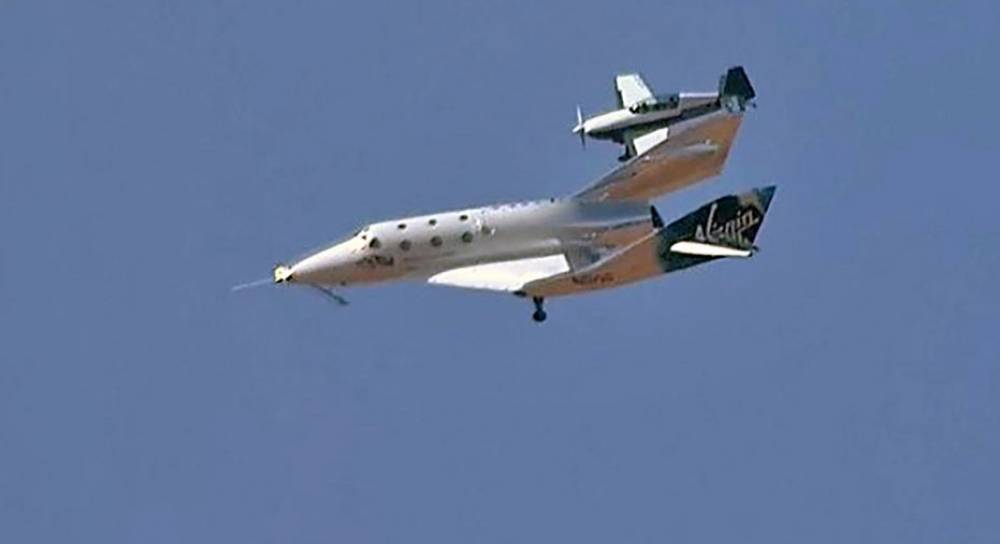
Richard Branson Reaches Space On Virgin Galactic Flight
Richard Branson reaches space on Virgin Galactic flight
Sir Richard Branson achieved his dream of reaching space after nearly 17 years of development and over a billion dollars invested in Virgin Galactic.
Branson described the spaceflight, speaking from the spacecraft's cabin, as a "once-in-a-lifetime experience."
“I've been dreaming of this moment since I was a child, and nothing prepares you for the view of the Earth from space,” Branson said following the landing.
On Sunday, Virgin Galactic's spacecraft VSS Unity launched above the skies of New Mexico, guided by two pilots. The vehicle carried the billionaire founder and three Virgin Galactic employees. VSS Unity fired its rocket engine and accelerated to more than three times the speed of sound in a climb to the edge of space after being released by a carrier aircraft called VMS Eve above 40,000 feet.
VSS Unity then executed a slow backflip in microgravity, while the Virgin Galactic crew floated around the spacecraft's cabin. The spacecraft ascended to 86.1 kilometers in altitude (53.5 miles, or about 282,000 feet).
The vehicle then glided back through the atmosphere, landing on the runway of Spaceport America from which it took off earlier.
Unity was piloted by Dave Mackay and Michael Masucci. In the spacecraft's cabin, Branson will be joined by chief astronaut trainer Beth Moses, lead operations engineer Colin Bennett, and vice president of government affairs Sirisha Bandla. Mackay and Masucci, as well as Moses and pilots C.J. Mark Stucky and Sturckow.
The United States officially recognizes astronauts as pilots who have flown above 80 kilometers (or approximately 262,000 feet).
VSS Unity is capable of transporting up to six passengers in addition to the two pilots. The company currently has approximately 600 reservations for future flights, which are priced between $200,000 and $250,000.
“Our mission is to make space more accessible to everyone,” Branson stated following the flight. “The mission statement I penned inside my spacesuit was to make my grandchildren's dream of space travel a reality... and for a large number of people alive today, for everyone.”
The spaceflight goals
This was Virgin Galactic's fourth spaceflight to date, its second this year, and the first to carry more than one passenger.
Along with flying Branson, the spaceflight accomplished additional objectives, as Virgin Galactic is still testing its spacecraft system in preparation for commercial service in early 2022.
The four crew members are evaluating the spacecraft's cabin and the training program developed by Virgin Galactic to ensure that customers are adequately prepared for the experience. Additionally, Bandla will practice conducting a research experiment while assisting the University of Florida with an exercise involving plants in test tubes.
Sunday's spaceflight is one of three still in development for Virgin Galactic, with two more expected this year.
A sweepstakes for others
Branson announced shortly after the spaceflight landed that Virgin Galactic would partner with sweepstakes company Omaze to offer two seats on "one of the first commercial Virgin Galactic spaceflights" early next year.
“You have the opportunity to travel to space,” Branson stated.
The sweepstakes requires a donation to Space For Humanity, a non-profit organization. The billionaire added that he will don his "Willy Wonka hat" and conduct a guided tour of Spaceport America for the winners.
“It's a way of trying to get a large number of people who couldn't afford to go to space otherwise to go to space,” Branson explained.
Branson’s journey
Branson has wanted to travel to space since he saw the Apollo moon landings and founded Virgin Galactic in 2004 to fly private passengers into space. He founded the company to acquire spacecraft developed by aerospace designer Burt Rutan's Scaled Composites. Scaled Composites developed the SpaceShipOne vehicle, which won a $10 million prize for flying twice to the edge of space in less than two weeks.
Virgin Galactic's SpaceShipTwo system was developed as a result of Branson's collaboration with Scaled Composites. However, the spacecraft's development has encountered numerous setbacks, including a ground-based rocket engine explosion in 2007 that killed three Scaled Composite employees and the 2014 crash of the first SpaceShipTwo vehicle, VSS Enterprise, which killed Virgin Galactic co-pilot Michael Alsbury and injured pilot Peter Siebold.
The company then constructed VSS Unity, which was designed with enhanced safety features to avert future accidents. Virgin Galactic began testing Unity in 2016 and launched it into space for the first time in December 2018. Additionally, Virgin Galactic rolled out the next spacecraft in its fleet earlier this year, the VSS Imagine, the first of the company's next-generation SpaceShip III class of vehicles.
Virgin Galactic received a license expansion from the United States last month. The company has received approval from the Federal Aviation Administration to fly passengers on future spaceflights. The company completed a 29-element verification and validation program for the FAA in May, passing the final two regulatory milestones.
Branson was not expected to fly on Sunday's spaceflight, as Virgin Galactic officials previously stated that the company planned to fly the founder on the company's second-to-last test flight. However, after fellow billionaire Jeff Bezos announced he would fly on the inaugural passenger flight of his company Blue Origin on July 20, Virgin Galactic rearranged its schedule to fly Branson nine days before Bezos.
Branson is the first billionaire space company founder to launch ahead of Jeff Bezos or Elon Musk on Sunday, making him the first billionaire space company founder to ride his own spacecraft.
Virgin Galactic and Blue Origin are competing in the suborbital space tourism market, with both companies' spacecraft transporting passengers to the edge of space for a few minutes of floating in microgravity. An orbital flight, such as one conducted by Musk's SpaceX, costs tens of millions of dollars and typically lasts several days or weeks.
Branson's company believes there is a market for suborbital spaceflights carrying up to 2 million people at a cost of $250,000 to $500,000, with the market expanding as costs decline.

